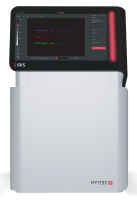Make it visible with IRIS
The new Alliance IRIS is the latest generation of top-end imaging systems for chemiluminescence and fluorescence Western blots. With an aperture of f/0.75, IRIS presents not only the highest optic sensitivity but also strong innovative features for unmatched precision and detection.
Revolutionary UV-LED Pad:
• Red is the new black: IRIS’s standalone design is a testament to its practicality and user-friendliness. It is easy to clean and compact enough to fit seamlessly into your laboratory environment. Inspired by the red square in our logo and the distinctive shape of the DNA molecule, its design connects IRIS to the essence of molecular research, symbolizing the pursuit of knowledge and discovery.
• Get the Cambridge Touch: Enjoy the comfort of the most comprehensive touch screen. With its impressive size of over 15.6 inches (40 centimeters), our Cambridge Touch screen offers an immersive and smooth viewing experience. The screen is also adjustable, and its remarkable resolution ensures that every detail of your molecular imaging experiment is vividly displayed.
• Avoid time-consuming manipulation: Our mobile sample tray has been designed to avoid time-consuming manipulations, ensuring that you can handle your samples with ease. Our Alliance IRIS imager also features a full-door aperture and slide-out trays, specifically engineered to alleviate the discomfort usually associated with draw-out transilluminators.
• Don’t miss the next UV-LED Pad generation: In the spirit of a sustainable environment, UVITEC Cambridge is the first to introduce UV-LED Pad technology to ensure a smooth transition from our traditional UV pads. UV-LEDs have a longer lifespan: they can operate for thousands of hours without significantly losing light intensity and efficiency. In addition, these LED conditions prevent damage to your most sensitive samples.
High-performance illumination:
• A brief history of excitation light sources: Traditional images that you will find on the market often rely on the following illumination modes.
• White light: The very first epifluorescence imaging systems used white light-based technology, converting white light into red, green, and blue via filters. However, multiplexing is impossible because the quantity of light is divided by three.
• Spot LED: The next-generation and most commonly found epifluorescence imaging systems use Spot LED technology. However, NIR/IR excitation channels originate from the same excitation source, decreasing the light intensity significantly in these channels. Depending on the manufacturer, filter quality varies, influencing crosstalk and multiplexing capacities.
• Scanner: The introduction of laser-based technology increased interest in near-infrared and infrared applications. However, this technology is expensive, requires long acquisition time, and is limited to 2 excitation channels.
• Find the right light source: Our well-known illumination system overcomes these challenges, providing intense light and multiplexing possibilities. The second generation Chromapure© goes beyond, offering the best of our technologies.
• Discover the next generation of illumination: Through its new technology, IRIS offers more accurate quantification and fewer crosstalk issues. The acquisition time is rapid. IRIS leaves no room for uncertainties by guaranteeing that your samples are scanned the same way everywhere.
• Choose a trusted companion: IRIS is made to last. In line with our top-end commitment and quality-oriented values, our system is entirely made of stainless steel and recycled components.
Fully automatic analysis:
• A revolutionary molecular imager: Experience effortless data analysis. IRIS integrates an unprecedented technology in molecular imaging and sets up your data as never seen before. IRIS serves as a faithful assistant, automating routine tasks and allowing you to go straight to analysis. The integrity of your raw data is maintained.
• Get your images in one click: Auto is our motto. Enjoy our one-click acquisition process with fully automatic exposure, lighting, and focus mode. Our software allows you to get outstanding quantifiable images and a perfect band saturation level. IRIS comes with a complete software analysis pack (molecular weight, protein quantification, or distance calculations) that you can install on as many computers as necessary.
• Upgrade your system anytime: IRIS is fully customizable, tailored to your workflow, and upgradeable through plug-and-play technology.
Wider lens aperture for unmatched sensitivity:
• Collect more light: IRIS has its eyes wide open: its lens features an impressive f/0.75 aperture, which allows it to capture an incredible amount of light. As you may know, the smaller the focal number in optics, the more light your device collects.
• Get the best quantifiable pictures: IRIS has a state-of-the-art camera with a remarkable 9.2-megapixel resolution. This high resolution ensures you can discern the finest details in your imaging experiments. In addition, our system provides pictures with a high density of grayscale within the camera, enabling you to analyze your samples precisely. The closer you get to 65,535 grey levels, the more quantifiable information you can access.
• Detect even the weakest signals: IRIS’ optical system is further enhanced by its exceptional dynamic range, with an optical density (OD) of 4.8. This means that IRIS can capture various signal intensities without losing crucial information. Whether you are working with faint signals or intense ones, IRIS can accommodate your needs with ease.
• Keep it cool: IRIS relies on a sophisticated cooling system using a three-stage Peltier normalized camera to maintain its sensitivity. This cooling system ensures an impressive -30°C absolute cooling, minimizing background noise and detecting your lowest signals.




